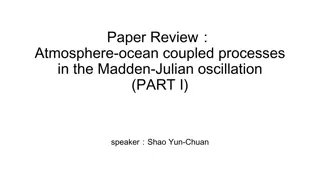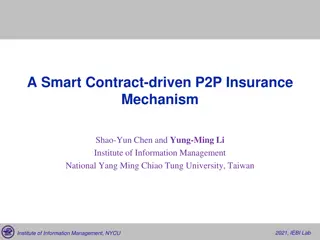
Innovative Approach for Smart Device Control Using Doppler Effect
Explore a cutting-edge method for controlling smart devices through audio-based movement tracking utilizing the Doppler effect. This unique approach offers precise positioning and accurate movement tracking, making it a promising technology for the era of smart devices.
Download Presentation

Please find below an Image/Link to download the presentation.
The content on the website is provided AS IS for your information and personal use only. It may not be sold, licensed, or shared on other websites without obtaining consent from the author. If you encounter any issues during the download, it is possible that the publisher has removed the file from their server.
You are allowed to download the files provided on this website for personal or commercial use, subject to the condition that they are used lawfully. All files are the property of their respective owners.
The content on the website is provided AS IS for your information and personal use only. It may not be sold, licensed, or shared on other websites without obtaining consent from the author.
E N D
Presentation Transcript
Turning a Mobile Device Turning a Mobile Device into into a Mouse a Mouse in the Air in the Air Sangki Yun, Yi-Chao Chen and Lili Qiu Department of Computer Science The University of Texas at Austin ACM MobiSys 2015, Florence, Italy
Era of Smart Devices Smart Devices
Our goal Controlling smart devices using existing mobile devices How to enable precise mobile device position tracking?
Possible solutions RF signal based device localization sub-meter level accuracy Accelerometer based device tracking not feasible due to huge noise Gyroscope track the rotational movement of the device
Our Approach Audio based movement tracking using Doppler effect Two speakers emit pure sinusoid tones in inaudible frequencies The device position is tracked by the Doppler shift of the recorded audio signal
Outline Background
Doppler Effect Doppler shift change in the frequency due to the movement of the sender or the receiver ?? --> ? =?? ??=? ?? ??: Doppler shift c: propagation speed of the medium ? : frequency of the wave
Why Doppler? (Why not accelerometer?) Compared to accelerometer, it is much more accurate to track the movement 8 0.5 Doppler shift (Hz) Acceleration (m/s2) 6 4 0 2 0 0 1 2 3 4 -0.5 Time (second) 0 1 2 Time (second) 3 4 5 Measured Doppler shift Acceleration while device is moving 20 Doppler Ground-truth Distance (cm) 15 20 Distance (cm) 10 0 -20 5 Accelerometer Ground-truth -40 0 0 1 2 3 4 0 1 2 Time (second) 3 4 5 Time (second) Movement estimated from the accelerometer Movement estimated from Doppler shift
Doppler based device movement tracking Accurately estimating the Doppler shift Tracking the position from the distance change Finding the distance between speakers Finding the initial position of the device Controlling a device with one speaker
Doppler shift estimation Short-term Fourier Transform (STFT) Observe the change of spectrum over time Use Hamming window to mitigate aliasing Detect the Doppler shift by finding the peak frequency with maximum magnitude 4 20 x 10 Power/Freq. (dB/Hz) Doppler shift (Hz) -50 1.79 10 -100 0 1.8 -10 1.81 -150 -20 0 1 2 3 0 1 2 3 4 Time (s) Time (second)
Improving the frequency shift estimation accuracy Utilize larger spectrum (Send 5 audio tones in 200 Hz interval) Outlier removal (Doppler shift change larger than 10 Hz) Maximal Ratio Combining 10 Doppler shift (Hz) 5 0 -5 -10 0 0.5 1 1.5 2 20 Time (second) Doppler shift (Hz) MRC without outlier removal 10 10 0 Doppler shift (Hz) 5 -10 0 -20 0 0.5 1 1.5 2 -5 Time (second) -10 0 0.5 1 1.5 2 Doppler shift from multiple channels Time (second) MRC with outlier removal
Tracking the device position - 1 Assumptions The distance between speakers is known The initial device position is known Measure Doppler shift from two speakers Using the previous position and Doppler, update new distance from speakers ? ? ??,1 ?1 ??,2 ?2 ??,1= ?? 1,1+ ? ?? ??,2= ?? 1,2+ ? ??
Tracking the device position - 2 Having the distance from two speakers, finding the position is finding the intersection of two circles (?,?) (?,?) ??,? ??,? (??,??) ??,? ??,? (??,??) ??,? (??,??) ??,? (??,??) (??,??)
Finding the distance between speakers Calibration to find the exact speaker distance using Doppler Moves the speaker from left to right, right to left T1: ??1 changes from positive to negative T2: ??2 changes from positive to negative 20 Doppler shift (Hz) 10 0 -10 1 Fs 2 -20 Fs 0 2 4 6 8 ?0 ?2 ?3 ?1 Time (second)
Finding the initial position (particle filtering) Initially allocate many particles in a given space 1,??1, , ?? ?,??? ? = ?? In each movement update, remove particles that give infeasible movement (i.e., D < D1 + D2) Update position by averaging the movement of all remaining particles ??+1,??+1 = ??+ ? ???+1 ? ? ? ? ? ,??+ ? ???+1 ?? ?? ?
Controlling a device with one speaker Leverage one speaker and one RF signal (WiFi or Bluetooth) Measure the change of the distance from speaker using Doppler shift Measure the change of the distance from RF source using phase change ??2 ??1 2? ??2= + ??1 ??: Distance at time t : wavelength of the signal ??: Phase of the received signal at time t Use the same mechanism to track the position
Implementation We implement AAMouse to enable real-time device tracking Mobile application collect audio signal from the microphone and deliver it to the tracking processor Tracking processor - track the device, visualize the current position For comparison, we also implement Camera based tracking (ground-truth) Accelerometer based tracking Gyroscope Moves the pointer by rotational movement of the device Used in commercial air mouse devices
Performance evaluation We performed user study with 8 students, and evaluated Tracking accuracy Target pointing Show a point on the screen Ask the user to point it Drawing Show a simple shape such as heart, circle, diamond, triangle Ask the user to draw it
Tracking accuracy AAMouse Median error: 1.4 cm 90th percentile error: 3.4 cm Not affected by background noise Accelerometer Median error: 17.9 cm 90th percentile error: 37.7 cm Accelerometer AAMouse without noise AAMouse with noise 1 CDF 0.5 0 -1 0 1 10 10 10 Trajectory Error (cm)
Target Pointing evaluation 1 R=Da / Ds Da: actual distance the pointer travels to reach the target Ds: Distance between the target and the origin 0 CDF 0.5 Camera AAMouse Gyroscope 0 1 2 3 4 5 6 Da / Ds 20 20 20 10 10 10 Distance (cm) Distance (cm) Distance (cm) 0 0 -10 -10 -10 -20 -20 -20 -20 -10 0 10 20 -20 -10 Distance (cm) 0 10 20 -20 -10 0 10 20 Distance (cm) Distance (cm) AAMouse Camera Gyroscope Samples from 80th percentile R
Drawing evaluation 1 Drawing error The distance between original shape and the drawn image CDF 0.5 Camera AAMouse Gyroscope 0 0.5 1 1.5 2 Drawing Error (cm) 30 30 30 30 30 30 20 20 20 20 20 20 Distance (cm) Distance (cm) Distance (cm) Distance (cm) Distance (cm) Distance (cm) 10 10 10 10 10 10 0 0 0 0 0 0 -10 -10 -10 -10 -10 -10 -20 -10 0 10 20 -20 -10 0 10 20 -20 -10 0 10 20 -20 -10 0 10 20 -20 -10 0 10 20 -20 -10 0 10 20 Distance (cm) Distance (cm) Distance (cm) Distance (cm) Distance (cm) Distance (cm) Gyroscope Camera AAMouse Samples from median drawing error
Conclusion We develop an audio based device tracking and apply it to realize mouse Future work Improving the accuracy and robustness of the tracking Realizing 3D tracking
Putting it all together Speaker distance calibration Initialize Particles Mobile device records audio signal and feeds back to processor Estimate the frequency shift and the velocity Compute the distance from each particle Compute new locations of particles and filter out particles with infeasible movement Find new location of the device
Micro benchmark - 1 Impact of using multiple sounds and outlier removal 3 3 Mean error (cm) Mean error (cm) 2.5 2.5 2 2 1.5 1.5 1 1 1 2 3 4 5 6 7 8 9 10 1 2 3 4 5 6 7 8 9 10 The number of sound tones The number of sound tones With outlier removal Without outlier removal
Micro benchmark - 2 Impact of the speaker distance calibration 1 2.5 Trajectory error (cm) 2 CDF 0.5 1 scans 3 scans 5 scans 1.5 0 1 0 5 10 15 20 0 5 10 15 20 Distance Error (cm) Speaker Distance error (cm) CDF of the speaker distance error Trajectory error with various speaker distance errors
Motivation Goal: precise device tracking technique to use a mobile device as Air mouse Applications Remote controller for Smart TV, Google Glass, laptop and PC Motion controller for gaming applications (e.g., X-Box Kinect, Nintendo Wii) Gesture recognition for Smart watch
Accelerometer based device tracking Accelerometers are equipped in most mobile devices Ideally, we can track the device position by double integration of the acceleration ? ? ? =?? ??, ? ? = ?(?)??, ? ? = ?(?)?? 0 0 In practice, hand vibration significantly affects the acceleration, and small error accumulate quickly due to double integration





